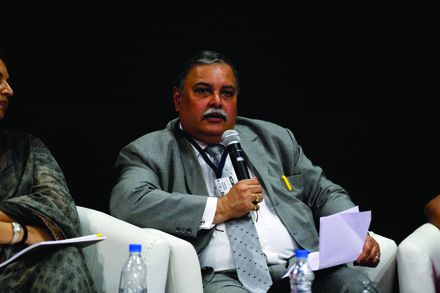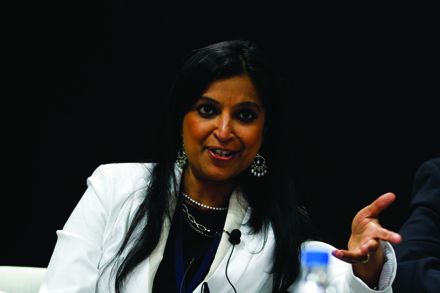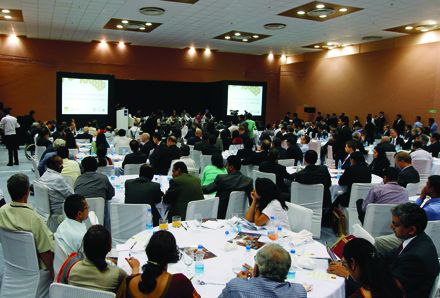To see the digital version of this report, please click here.
IFR: What opportunities lie in the equity market for infrastructure companies, especially when we are talking about a very significant US$130bn of equity to be raised for infrastructure by 2017?
Sanjay Nayar: Public equity markets are not the right way to go. You’ve got to have promoter money, state support and long-term pension and insurance money from within the country first and then internationally. Public equity markets were a bit of fashion when everyone went out and raised money on the basis of a one-page plan, but I think that has done more harm than any good. We have too many listed companies in India. Maybe they listed too early, when they were too small.
Infrastructure companies who do not have a solid platform with some real cash flows have no reason to go public. What are you going to sell to investors? Are they going to look for 26% pop in market price? Of course not. But that’s what happened. Our markets were a little shallow. This time around SEBI is going to be very tough in approving projects and I think that’s the right way to look at it.
We have invested in a company and we are looking at doing an IPO, and it is going to be a very difficult approval process. I think you should not look to public markets for the kind of stuff we are talking about here.
Look at the savings rates here. I don’t want to bring up the development of the corporate bond markets, or insurance, which is a topic by itself, but the money is all here. All these things will change slowly. The Insurance Regulatory and Development Authority will open up, pension money will begin to come in and the statutory liquidity ratio will come down.
IFR: There is a lot of debate about whether India should look to overseas to raise debt? Do you reckon a sovereign bond would eventually be a good idea when we have all these structural issues in place?
Sanjay Nayar: Sovereign bonds are issued by a lot of countries, and if you can manage the proceeds well and have the right kind of covenants with institutional investors, I think it is a terrific idea. What you need to do is to sign a covenant that says total debt to GDP will be X, just as when a company takes a project finance bond, you sign a debt covenant. So if somebody’s got the guts to sign a debt covenant, I think India would do very well with a sovereign bond of 30–40 years. People will lap it up. I think we will get a rate which is as good as or even better than a lot of countries who are seemingly rated better than us because, as I said, foreign money loves India. But the issue of how the proceeds would be used is critical.
IFR: We will throw open the floor for questions now. The first is from SC Jha, former ADB chief economist and former economic advisor to the Prime Minister of India.
SC Jha: I have some basic differences of view with some of your panellists. We have participants from across the globe here and they would know that India passed through a difficult period from 1958 to 1965 when GDP growth was 3.5%. From the late 80s up to 2008–09, we had a 9% growth rate and now we are at 5%. It is rather unique for an emerging economy to have a 5% growth rate, and this has far-reaching implications for the democracy of India, for its poverty, unemployment and a variety of things. We urgently need to accelerate economic growth. How much outside/external capital can we generate for infrastructure financing?
Sharmila Chavaly: I appreciate what Mr. Jha has said on how far India has come from the 1950s. It is very easy to take steps in the short term where we get funds, but we also have to see what the repercussions are. The repercussions from the ministry of finance point of view will also include things like inflation. It is nobody’s case that the private sector is going to finance all the infrastructure in India. If we say 47% of the money will come from the private sector, it does not mean that the money will come only through PPPs. It can come from various modalities and instruments.
One of the speakers has spoken about the large savings rate in India. We need to see how we can attract that saving into investment in infrastructure. These kinds of things are being addressed. Bond market issuance is being addressed. There can be frustration over the pace of change but the path of reform has remained unchanged.
IFR: Sanjay, Is there anything else which keeps you awake at night?
Sanjay Nayar: Getting to the office on the roads on which we travel in Bombay, that keeps me awake. But leaving that aside, what keeps us awake frankly is the delays. Project delays carry a real economic cost. What also bother us are the reasons for the delays. Trivial reasons for delays can be very frustrating.
IFR: Suneet, you wear lot of hats, including that of developer and investor. Have you found any solutions to the challenges discussed? How optimistic are you towards these challenges?
<div class="inline_image_right inline_image" data-attachment="207902" style="width: 220px;"><p class="picture"><img alt="IFR Asia Funding India’s Infrastructure Roundtable 2013: Part 4" src="/MediaFiles/Browse/8ff7eee9-3acf-46d0-b99f-d263561c4ef7"></p></div>Suneet Maheshwari: India has been growing tremendously in the last few years at 8% or 9%. But there are delays. What really bothers us, or will bother any of the bankers, is that it takes a lot of time to unwind positions. This CCI initiative to fast-forward all clearances seems to be a step in the right direction. There are problems in any economy, but if we can develop a mechanism to resolve these challenges then it will be a good thing.
“What really bothers us, or will bother any of the bankers, is that it takes a lot of time to unwind positions.”
In this whole discussion on PPPs, lots of people have remembered the first two Ps of private and public aspects, but somewhere the last P of partnership has been forgotten. Both sides need to understand that there is a fair bit of give and take. It is only when there is money on both the sides that the project actually wins.
You have had developers who have done securitisations based on higher toll rates and in an economic downturn they are unable to pay the debt raised on the back of these securitisations. So even the leveraging of holding company operations can go wrong during an economic downturn, even though they seemed okay during the boom time. So we are going through a process of adjustment and people on both sides are learning.
Question: I spend a lot of time analysing termination risk in projects. Following the expiry of lenders’ second rights [termination of contracts for any reasons] and unless the state essentially underwrites lender debt and pays them out, I can’t see how you can create a bankable project structure. Would the panel agree?
Arundhati Bhattacharya: There are more requirements for state guarantees in the construction phase rather than after construction. Actually, when we are talking about IDFs etc, where we are talking about foreign investment, it would be in those projects that the completion has already occurred and there is a cash flow which is actually visible for at least a year. It is in this area of takeout financing that we are expecting foreign investors to come in.
However, if you are talking about projects under implementation and you are asking there to be guarantees to enable investors to come in even at that stage, well we have found that most of the lending is being done by banks who are willing to take this risk, mainly because they are aware of the capabilities of the promoters. We have really not got investors coming in that stage. In fact, I think getting investors at that stage is something which we can look for only a few more years down the line when we already have a history of well-completed projects.
We have also found that many foreign investors are quite keen to come in even without these guarantees as long as they are quite clear about the project’s cash flows. And, the second thing that they look for is absolute clarity and consistency in regulations.
This point has been repeated here during the discussion, that clarity and consistency are two things that investors look for. None of the investors are willing to come in unless they are very sure they understand all the risks, and obviously they don’t want to suddenly re-orient themselves to new risks that arise on account of changes that happen with retrospective effect.
Lakshmi Venkatachalam: We agree that the direction of the policies is on the right trajectory, but what we need now is a sense of urgency to sort, really quickly, some successful projects. This is very important as nothing succeeds like a good, demonstrable, successful project that can show risk-adjusted good returns to the investor and to the developer.
So, in the second wave of reforms we are carrying out, allowing a reasonable return to the investor, having firm regulatory policies in place and good success stories will have positive impact of bringing in more investment.
Question: There seems to be two animals here. One is primary financing and one is secondary financing. For primary financing for construction of an infrastructure project, we are not going to get a single dollar. Investors are going to come in the secondary financing when everything is up and running when the caterpillar of the infrastructure project becomes a butterfly.
Let’s get to this magical figure of US$1trn – or should we get to rupees as the depreciation of the rupee has changed this number. What is the sense each panel member has that over the next five years, out of this Rs51trn, how much we will actually be done in India?
<div class="inline_image_right inline_image" data-attachment="207903" style="width: 220px;"><p class="picture"><img alt="IFR Asia Funding India’s Infrastructure Roundtable 2013: Part 4" src="/MediaFiles/Browse/f4ec61cd-79f2-4b20-9ee8-cbe0ffd5894a"></p></div>Atsi Sheth: If you look at history, India has achieved its investment target but it has been skewed towards certain sectors, with sectors such as telecoms and oil and gas outperforming and power and roads under-performing. Last time, the target of investment was met 95% so even this time the target could be met to the extent of Rs50trn. But it may not be met in the manner that the country needs.
“If the corporate sector is to achieve higher scale and compete effectively, it somehow has to address infrastructure bottlenecks or pay for better infrastructure.”
Amit Kapur: We will get the numbers. But we are also forgetting that there is one more animal in the room: entrepreneurship is all about risk-taking. We cannot have state guarantees for private investment. You must be thinking that you are in a banana republic but you are not. We have a track record that is already established. I don’t see any reason why the investment will not happen. We have the tendency to go through the pain before coming around to it. We don’t do it quickly, that’s the only challenge.
<div class="inline_image_right inline_image" data-attachment="207904" style="width: 220px;"><p class="picture"><img alt="IFR Asia Funding India’s Infrastructure Roundtable 2013: Part 4" src="/MediaFiles/Browse/e35861c0-304c-403e-a657-6de91517d9d3"></p></div>IFR: Ladies and gentlemen, thank you for your comments.


